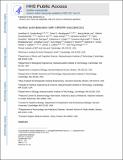| dc.contributor.author | Lee, Jeong Wook | |
| dc.contributor.author | Essletzbichler, Patrick | |
| dc.contributor.author | Verdine, Vanessa | |
| dc.contributor.author | Donghia, Nina | |
| dc.contributor.author | Freije, Catherine A. | |
| dc.contributor.author | Myhrvold, Cameron | |
| dc.contributor.author | Bhattacharyya, Roby P. | |
| dc.contributor.author | Livny, Jonathan | |
| dc.contributor.author | Koonin, Eugene V. | |
| dc.contributor.author | Pardis, C. Sabeti | |
| dc.contributor.author | Gootenberg, Jonathan S | |
| dc.contributor.author | Dy, Aaron James | |
| dc.contributor.author | Joung, Julia | |
| dc.contributor.author | Daringer, Nichole Marie | |
| dc.contributor.author | Regev, Aviv | |
| dc.contributor.author | Hung, Deborah T | |
| dc.contributor.author | Collins, James J. | |
| dc.contributor.author | Zhang, Feng | |
| dc.contributor.author | Abudayyeh, Omar O. | |
| dc.date.accessioned | 2017-12-14T14:34:12Z | |
| dc.date.available | 2017-12-14T14:34:12Z | |
| dc.date.issued | 2017-04 | |
| dc.date.submitted | 2017-02 | |
| dc.identifier.issn | 0036-8075 | |
| dc.identifier.issn | 1095-9203 | |
| dc.identifier.uri | http://hdl.handle.net/1721.1/112745 | |
| dc.description.abstract | Rapid, inexpensive, and sensitive nucleic acid detection may aid point-of-care pathogen detection, genotyping, and disease monitoring. The RNA-guided, RNA-targeting clustered regularly interspaced short palindromic repeats (CRISPR) effector Cas13a (previously known as C2c2) exhibits a "collateral effect" of promiscuous ribonuclease activity upon target recognition. We combine the collateral effect of Cas13a with isothermal amplification to establish a CRISPR-based diagnostic (CRISPR-Dx), providing rapid DNA or RNA detection with attomolar sensitivity and single-base mismatch specificity. We use this Cas13a-based molecular detection platform, termed Specific High-Sensitivity Enzymatic Reporter UnLOCKing (SHERLOCK), to detect specific strains of Zika and Dengue virus, distinguish pathogenic bacteria, genotype human DNA, and identify mutations in cell-free tumor DNA. Furthermore, SHERLOCK reaction reagents can be lyophilized for cold-chain independence and long-term storage and be readily reconstituted on paper for field applications. | en_US |
| dc.description.sponsorship | United States. Air Force Office of Scientific Research (Grant FA9550-14-1-0060) | en_US |
| dc.description.sponsorship | Defense Threat Reduction Agency (DTRA) (Grant HDTRA1-14-1-0006) | en_US |
| dc.description.sponsorship | National Institute of Mental Health (U.S.) (Grant 5DP1-MH100706) | en_US |
| dc.description.sponsorship | National Institutes of Health (U.S.) (Grant 1R01-MH110049) | en_US |
| dc.publisher | American Association for the Advancement of Science (AAAS) | en_US |
| dc.relation.isversionof | http://dx.doi.org/10.1126/SCIENCE.AAM9321 | en_US |
| dc.rights | Creative Commons Attribution-Noncommercial-Share Alike | en_US |
| dc.rights.uri | http://creativecommons.org/licenses/by-nc-sa/4.0/ | en_US |
| dc.source | PMC | en_US |
| dc.title | Nucleic acid detection with CRISPR-Cas13a/C2c2 | en_US |
| dc.type | Article | en_US |
| dc.identifier.citation | Gootenberg, Jonathan S. et al. “Nucleic Acid Detection with CRISPR-Cas13a/C2c2.” Science 356, 6336 (April 2017): 438–442 © 2016 American Association for the Advancement of Science | en_US |
| dc.contributor.department | Massachusetts Institute of Technology. Institute for Medical Engineering & Science | en_US |
| dc.contributor.department | Harvard University--MIT Division of Health Sciences and Technology | en_US |
| dc.contributor.department | Massachusetts Institute of Technology. Department of Biological Engineering | en_US |
| dc.contributor.department | Massachusetts Institute of Technology. Department of Biology | en_US |
| dc.contributor.department | Massachusetts Institute of Technology. Department of Brain and Cognitive Sciences | en_US |
| dc.contributor.department | McGovern Institute for Brain Research at MIT | en_US |
| dc.contributor.mitauthor | Gootenberg, Jonathan S | |
| dc.contributor.mitauthor | Abudayyeh, Omar Osama | |
| dc.contributor.mitauthor | Dy, Aaron James | |
| dc.contributor.mitauthor | Joung, Julia | |
| dc.contributor.mitauthor | Daringer, Nichole Marie | |
| dc.contributor.mitauthor | Regev, Aviv | |
| dc.contributor.mitauthor | Hung, Deborah T | |
| dc.contributor.mitauthor | Collins, James J. | |
| dc.contributor.mitauthor | Zhang, Feng | |
| dc.relation.journal | Science | en_US |
| dc.eprint.version | Author's final manuscript | en_US |
| dc.type.uri | http://purl.org/eprint/type/JournalArticle | en_US |
| eprint.status | http://purl.org/eprint/status/PeerReviewed | en_US |
| dc.date.updated | 2017-12-12T16:12:17Z | |
| dspace.orderedauthors | Gootenberg, Jonathan S.; Abudayyeh, Omar O.; Lee, Jeong Wook; Essletzbichler, Patrick; Dy, Aaron J.; Joung, Julia; Verdine, Vanessa; Donghia, Nina; Daringer, Nichole M.; Freije, Catherine A.; Myhrvold, Cameron; Bhattacharyya, Roby P.; Livny, Jonathan; Regev, Aviv; Koonin, Eugene V.; Hung, Deborah T.; Sabeti, Pardis C.; Collins, James J.; Zhang, Feng | en_US |
| dspace.embargo.terms | N | en_US |
| dc.identifier.orcid | https://orcid.org/0000-0002-7979-3220 | |
| dc.identifier.orcid | https://orcid.org/0000-0003-0319-5416 | |
| dc.identifier.orcid | https://orcid.org/0000-0001-6656-5002 | |
| dc.identifier.orcid | https://orcid.org/0000-0002-2026-8130 | |
| dc.identifier.orcid | https://orcid.org/0000-0001-8567-2049 | |
| dc.identifier.orcid | https://orcid.org/0000-0002-5560-8246 | |
| dc.identifier.orcid | https://orcid.org/0000-0003-2782-2509 | |
| mit.license | OPEN_ACCESS_POLICY | en_US |
